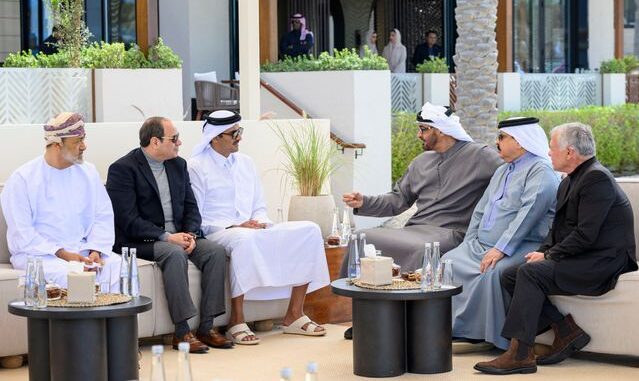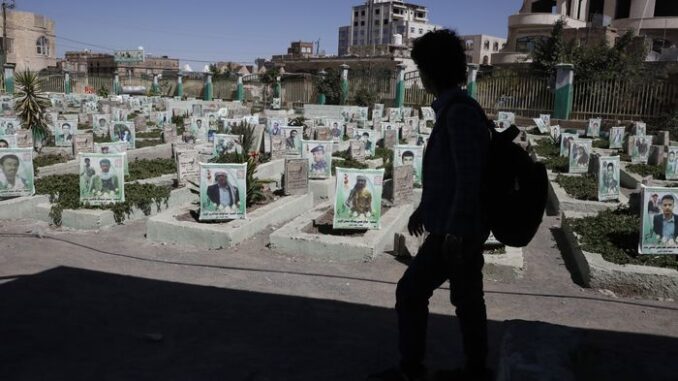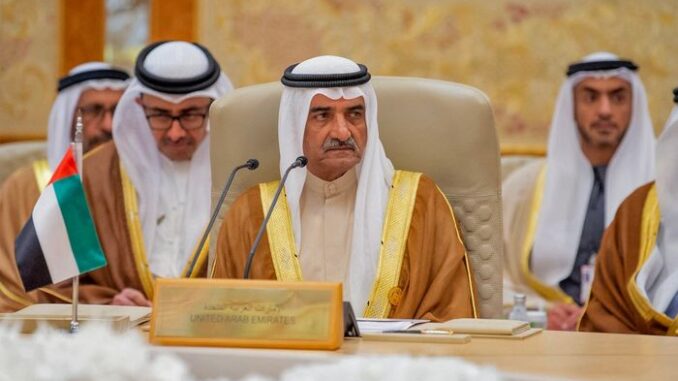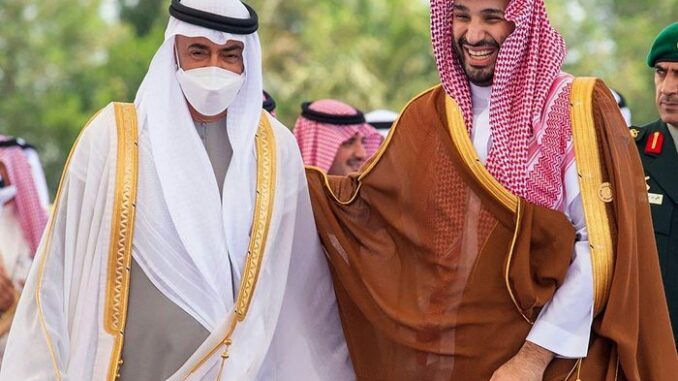Once close friends, the two biggest Arab economies are increasingly competing for money and power

Middle East leaders at a regional event in January.PHOTO: HAMAD AL-KAABI/AGENCE FRANCE-PRESSE/GETTY IMAGES
DUBAI—When Abu Dhabi hosted a summit of Middle East leaders at a seaside palace in January, there was a glaring absence: Saudi Crown Prince Mohammed bin Salman. A month before, the United Arab Emirates’ top leaders skipped a high-profile China-Arab summit in Riyadh.
Prince Mohammed and U.A.E. President Sheikh Mohamed bin Zayed al Nahyan steered clear of each other’s events intentionally, Gulf officials said, even as the rulers of Jordan, Egypt, Qatar and others attended. The snubs exposed a growing rift between neighboring U.S. security partners that for years marched in lockstep on Middle East foreign policy.
Still formally allies, Saudi Arabia and the U.A.E. have diverged on several fronts, competing for foreign investment and influence in global oil markets and clashing on the direction of the Yemen war. The disagreements once unfolded behind closed doors but are increasingly spilling out into the open, threatening to reorder alliances in the energy-rich Persian Gulf at a time when Iran is trying to exert more sway across the region and Russia’s war in Ukraine has raised crude prices and roiled OPEC decision-making.
U.A.E. national security adviser Sheikh Tahnoun bin Zayed al Nahyan, who is close to Prince Mohammed, has repeatedly traveled to the Saudi kingdom to meet its 37-year-old de facto leader, but that has failed to ease tensions, said people familiar with the trips. On at least one occasion after the January summit in Abu Dhabi, Sheikh Tahnoun couldn’t secure a meeting with the Saudi crown prince, some of the people said.
The U.A.E.’s Sheikh Mohamed, 61 years old, was once the Saudi crown prince’s mentor, bonding a few years ago on an overnight camping trip in the vast Saudi desert, accompanied by trained falcons and a small entourage, The Wall Street Journal has reported. But more recently, the two men have drifted apart as they offer divergent visions of leadership, and with Sheikh Mohamed avoiding the scrutiny faced by Prince Mohammed.
“Up until a few years ago, this sort of division and openly pursuing objectives that are counter to what their brothers are pursuing was unheard of,” said Dina Esfandiary, senior adviser for the Middle East and North Africa at the International Crisis Group. “Now it’s becoming increasingly normal.”
Emirati officials declined to comment. Saudi officials didn’t respond to requests for comment.

At a cemetery in San’a, Yemen, portraits sit on the graves of people who have been killed during the conflict.PHOTO: YAHYA ARHAB/SHUTTERSTOCK
In a tweet in February, Anwar Gargash, an Emirati foreign-policy adviser to Sheikh Mohamed, reaffirmed the U.A.E.’s unity with Saudi Arabia and said reports about shifts in Gulf alliances are wrong and create divisions at a time when the region needs solidarity.
The most intense disagreement is over Yemen, where the Saudis and Emiratis led an Arab military coalition that intervened in 2015. The civil war has left the country fractured between Iran-backed Houthi rebels controlling the north and an internationally recognized government in much of the south.
The U.A.E. pulled most of its ground forces from Yemen in 2019 but still fears being sidelined from discussions about its future as Saudi Arabia pursues direct talks with Houthi rebels on ending the war, Gulf officials said. The U.A.E. wants to maintain a strategic foothold on the country’s southern coast and project power into the Red Sea to secure sea routes from its ports to the rest of the world, Gulf officials said.
In December, the U.A.E. signed a security agreement with the Saudi-backed Yemeni government allowing Emirati forces to intervene in the country in the case of an imminent threat, train Yemeni forces in the U.A.E. and deepen intelligence cooperation, according to Saudi, Emirati and Western officials. The U.A.E. is also seeking to build a military base and runway on an island in the Bab al-Mandeb strait at the southern end of the Red Sea, according to Gulf officials.
Saudi officials privately objected to the security agreement and plans for the base, Gulf officials said, and view the Emiratis as working against Riyadh’s main objectives of securing its 800-mile border and stopping Houthi drone and missile attacks.
In response, the Saudis deployed Sudanese forces from the Arab military coalition to areas near Emirati operations, which Emirati officials saw as an intimidation tactic, Gulf officials said.
In December, when Sheikh Mohamed didn’t attend the China summit in Riyadh, Saudi officials say they interpreted it as a sign of Emirati displeasure over the rising competition in Yemen. In Sheikh Mohamed’s place, the ruler of the small emirate of Fujairah attended the summit featuring Chinese leader Xi Jinping.
Two of the biggest oil producers in the world, the Saudis and Emiratis have also had behind-closed-doors arguments over energy issues.
Within the Saudi-led Organization of the Petroleum Exporting Countries, the U.A.E. is obligated to pump much less than it is capable of, hurting its oil revenue. It has long pushed to pump more oil, but the Saudis have said no, OPEC delegates have said.
Emirati officials say the U.A.E. is having an internal debate about leaving OPEC, a decision that would shake the cartel and undermine its power in global oil markets. Departing OPEC has been discussed for years in the U.A.E. leadership without action, but Emirati officials said recent disagreements with Saudi Arabia had rekindled the idea.

Abdullah bin Zayed al Nahyan, the U.A.E.’s minister of foreign affairs and international cooperation, leans behind Hamad Al-Sharqi, the ruler of Fujairah.PHOTO: BANDAR AL-JALOUD/AGENCE FRANCE-PRESSE/GETTY IMAGES
The Emiratis clashed with the Saudis last October when OPEC+—a 13-nation group that includes OPEC and 10 other countries, including Russia—decided to dramatically reduce oil production to prop up crude prices.
In public, the U.A.E. supported the production cut. But U.S. officials said the Emiratis told them privately that they wanted to pump more, in line with Washington’s wishes, but faced resistance from Saudi Arabia. Since then, the U.A.E. has privately pushed OPEC+ to let it produce more, Gulf energy officials said.
The Emiratis are “worried about a Saudi that works against their interests,” said Ms. Esfandiary. She said the Saudis are concerned the U.A.E. poses a threat to Saudi dominance in the Gulf.
The Saudi-U.A.E. rift isn’t as serious as Qatar’s dispute with its neighbors, which saw diplomatic, trade and travel ties severed from mid-2017 until early 2021. The Saudis and the Emiratis continue to participate in joint military exercises, but the heyday of their alignment is over, analysts said.

Saudi Crown Prince Mohammed bin Salman with his hand on the back of U.A.E. President Mohamed bin Zayed al Nahyan.PHOTO: -/AGENCE FRANCE-PRESSE/GETTY IMAGES
The divergence began after the 2018 killing of Saudi journalist Jamal Khashoggi by Saudi government agents, which made the Emiratis reconsider how close they should be to him, Emirati officials said. In 2019, the Saudis felt abandoned in Yemen when Abu Dhabi began pulling its forces. A U.A.E. deal establishing relations with Israel generated more friction.
Riyadh’s quick reconciliation with Doha after it pushed to end the boycott in early 2021 alarmed Abu Dhabi, which had originally pushed for isolating Qatar and wanted to continue the blockade, officials and diplomats have previously said. The Saudis have leaned on foreign companies to move their regional headquarters to the kingdom, challenging the position of Dubai, the Emirati city-state that is the Middle East’s international business hub.
A potential realignment in the Gulf seemed to take shape in November when the king of Bahrain, long seen as a Saudi client state, appeared at a Formula One race in Abu Dhabi alongside Sheikh Mohamed on the same weekend the Saudi prince attended the soccer World Cup opening ceremony in Doha with the Qatari ruler.
Last month the U.A.E. arranged a phone call between the leaders of Qatar and Bahrain, which have had frosty ties for years. The U.A.E. played the regional power-broker role once reserved for Saudi Arabia.
Benoit Faucon, Saleh Al-Batati and Michael Amon contributed to this article.



I hope the Saudi’s and U.A.E along with a few others get in a oil war and drive the price of oil back down to 1980 levels.
http://bible.oremus.org/?passage=1+Maccabees+8:17%E2%80%9320:17&version=nrsvae
https://youtu.be/djZkTnJnLR0
The Roman Empire.
@Peloni Alliances with and between Arab tribes and nations are by definition built on sand. Let’s just hope the Abraham Accords can last long enough to be an effective bulwark against Iran until – hopefully- that regime is overthrown by its people. And we should go easy on the sentimentality. “Friends” of today will turn on us in s heartbeat when it suits their interests. They always have. Not just Arabsj, Muslims, leftists, . France, Britain. The international Community. post League of Nations.
Interesting and and concerning. The role played by the UAE in the recent debacle supporting the Pals, despite them being signatories to the Abraham Accords was a important statement, should not be ignored. Indeed, when transposed on top of this report, it raises many questions and many concerns.